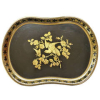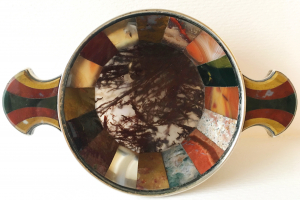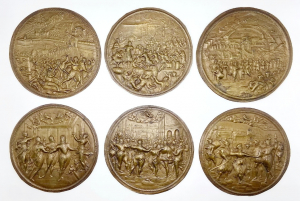A tray
A papier mache tray
Shaped oval, the centre painted with flowering branches of roses with a bird and a butterfly, the border with a band of acorns and oakleaves.
The first patent for paier mache was registered by Henry Clay of Birmingham in 1772. Papier mache is an art of highly refined and skilled craftsmanship. Though tedious and laborious in the making, the finished work itself conveys a sense of elegant simplicity.
Ten or so sheets of unsized paper were glued and then lauered on a metal or wooden mold. Each sheet was covered with a paste or glue that had been dissolved in water and smoothed out by pressing out any air bubbles. The work was then trimmed, dipped in linseed oil to make it waterproof and dried in an oven. Afterwards it was smoothed once again, preparing the surface for decoration. The object would now be cut, chiselled or worked into various functional articles. One of the most popular was the teatray.
Altough coloured base grounds were sometimes used, the majority of Georgian period pieces had a black base color. The ground color is a black tar varnish made with a combination of oils. Gold leaf was used most frequently in decoratin Georgian papier mache. The method of gold leaf was to first pencil trace a design onto an object, then paint over the design with an adhering paste. Before the paste dried completely, the gold leaf was pressed on and was set aside for several days to harden. The gold leaf that did not adhere was polished off, with the positive design remailing. To be successful this process required the delicate sensitivity of a skilled craftsman.
- Price
- Period
- 19th century
- Material
- Papier-maché
- Dimensions
- 41.5 x 30 cm
- Reference
- 0258










